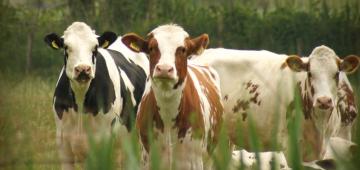Agricultural Communication (Journalism) Concentration
Advanced Agriculture Business Management
Agriculture Business Records and Business Planning
Agriculture Commodity Marketing
Agriculture Financial Analysis
Agriculture Market Plan Development
Agriculture Profit Maximization
Rural Business Entrepreneurship
This program is designed for beginning and/or experienced agriculture operators who wish to develop or improve upon their financial management skills and gain knowledge of how to improve business operations.
The uniqueness of this program comes from the one-on-one instruction that takes place at a convenient location for the student. In today's agriculture climate, management means being a decision-maker who is attuned to all dimensions of the working environment.
Program Learning Outcomes:
- Improve awareness of personal and business finances through computerized record-keeping.
- Use financial statements to assess the financial health of the business
- Utilize appropriate industry language to communicate with bankers, accountants, and other professionals in the industry.

According to the Bureau of Labor Statistics employment of farmers, ranchers, and other agricultural managers is projected to decline 5 percent from 2022 to 2032.
Despite declining employment, about 88,800 openings for farmers, ranchers, and other agricultural managers are projected each year, on average, over the decade. All of those openings are expected to result from the need to replace workers who transfer to other occupations or exit the labor force, such as to retire.
Employment
Over the past several decades, increased efficiencies in crop production have led to consolidation and fewer, but larger, farms. This means that fewer farmers are needed to produce the same agricultural output. In addition, as farms become larger, they invest more in productivity-enhancing technologies, reinforcing this effect.
Despite steady demand for agricultural products, many small farms operate with slim profit margins and are vulnerable to poor market conditions. As in the past, operators of small farms will likely continue to exit the business over the decade.
The U.S. Bureau of Labor Statistics lists the median annual wage for farmers, ranchers, and other agricultural managers was $75,760 in May 2022. The median wage is the wage at which half the workers in an occupation earned more than that amount and half earned less. The lowest 10 percent earned less than $37,440, and the highest 10 percent earned more than $139,040.
Incomes of farmers and ranchers vary from year to year because prices of farm products fluctuate with weather conditions and other factors. In addition to earning income from their farm business, farmers may receive government subsidies or other payments that reduce some of the risks of farming.
Most farmers, ranchers, and other agricultural managers work full time, and many work more than 40 hours per week. Farm work is often seasonal, and the number of hours worked may change according to the season. Farmers and farm managers on crop farms usually work from sunrise to sunset during the planting and harvesting seasons. During the rest of the year, they plan the next season’s crops, market their output, and repair and maintain machinery. Managers of greenhouses, nurseries, or farms that operate in mild or temperate climates may work year round.
On livestock-producing farms and ranches, work goes on throughout the year. Animals must be fed and cared for daily.
- Produce a written document that clearly explains an agricultural concept.
- Analyze information and use critical thinking to solve an agricultural problem.
- Explain how agriculture relates to global, social, and cultural concepts.
- Develop skills useful in the agriculture industry or transfer to an agricultural degree.
- Apply scientific information and the scientific method to explain agricultural concepts.















